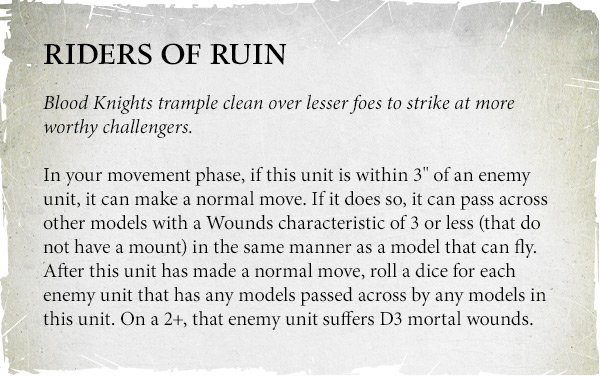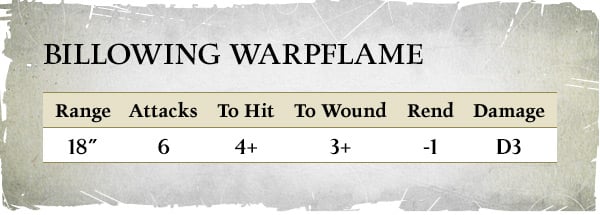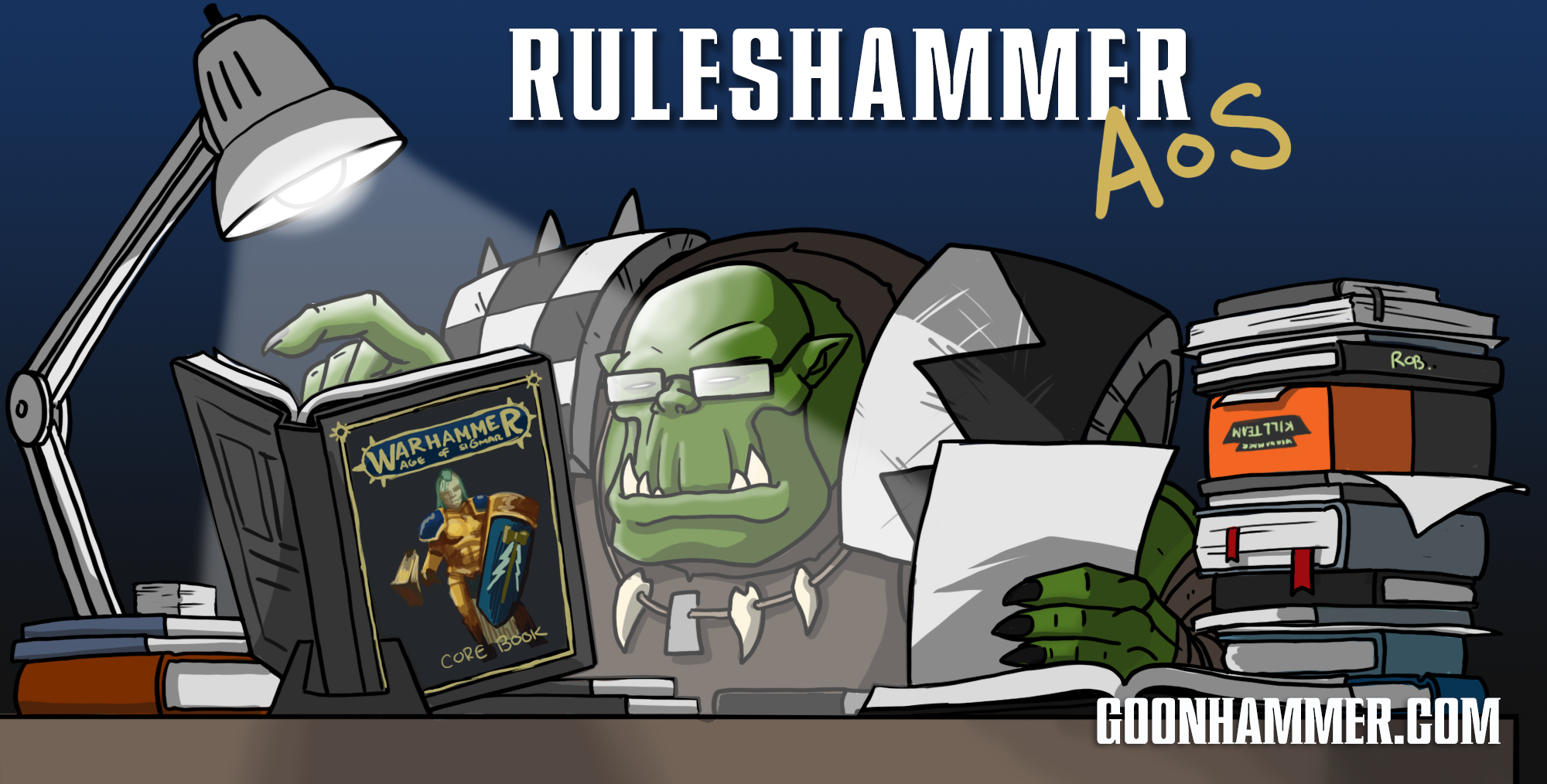The new edition of Age of Sigmar is here and we’re doing daily deep dives into the ways the edition’s rules have changed and what those changes mean for players. Today we’ll be looking at how the Movement and Shooting phases have changed in 3rd edition – discussing the new types of movement actions and reactive command abilities you have in your arsenal to outplay your foes.
Movement Phase
The movement phase is where a lot of the action happens. While maybe not as flashy as throwing lots of dice in the shooting phase or micromanaging melee combat during pile-ins it’s where you set up your charges, secure objectives and move into the best position to fire your guns. In the 3rd edition of Age of Sigmar, movement still works pretty much the same in the broad scale but when you look at a lot of the nuance you have a lot more options for movement than you did in the past.
Move, Retreat, Run
During the movement phase you get to move every one of your units, if you so choose. If you choose not to activate a unit, it counts as not moving, which some units like the new Man-Skewer Boltboyz benefit from.
You have three distinct types of movement, which you declare before moving a unit. For all 3 you cannot end a move within 3″ of an enemy unit, that’s what the charge phase is for!
- Normal Move – You consult your units movement characteristic and you can move up to that number in inches.
- Retreat – A slightly different kind of move, for when you are locked into combat. For all intents and purpose it’s a normal move (move up to your warscrolls movement value) but you cannot shoot or charge the turn that unit retreated. This rule did exist previously but in a slightly different form. Before you could fall back and Run but since Retreat is a distinct movement action you can no longer do this, making it harder to escape than before.
- Run – Similar to a Normal Move above, but you roll a dice and add that number to your movement characteristic. Similar to retreating you cant charge or shoot the same phase you ran (unless of course your warscroll says you can). Useful if you’re not planning to shoot or charge that turn anyway and really need the extra distance.
Pretty straight forward. Compared to last edition it’s mostly the same, although making retreats a distinct action helps clear up some ambiguity about Blood Knights

Since it says you can make a normal move despite being within 3″, making it clear that a retreat and normal move are different actions is a huge clarifier. Now, onto some more exciting stuff.
Command Abilities
There is a set of generic command abilities in the movement phase to spice things up, one returning and one brand new.
- At the Double – If you really need to make sure you get a 6″ on a run roll to get to where you’re going (Say to get as many models on an objective as possible) you can burn a CP to do this. Note you must do this before you roll! No being a sore loser cause you got a 1.
- Redeploy – Brand new to 3.0 and probably one of the most interesting changes in the game. Used in your opponent’s movement phase, if they end a movement within 9″ of one of your units and more than 3″ from an enemy units you can choose to immediately activate that unit and move D6″, but it must end its move more than 3″ from the enemy as usual.
Redeploy is what’s going to get a lot of people talking. It can get a bit dodgy, like running you might get a 1 and not be able to do much but the ability to immediately react to an opponent’s move has some serious repercussions on the game. What sorts of things could you do?
- The most obvious one is to move a unit away if it looks like the enemy is moving to charge them. Even a couple of inches can drastically reduce the odds of them being able to make a charge.
- Did you fall short of an objective during your movement? If an enemy just moved within 9″ of you, make a last ditch chance to run for it.
- If you don’t think you can get far enough away to escape a charge, move another unit in to block the vulnerable unit instead.
There’s a lot of exciting ways this could be used with a lot of clever thought, it almost seems a little too good. It could still fail you but the risk could be worth it.
Unique Movement
You won’t always be simply moving across an open field. Terrain can get in your way and really gum up the works. If you need to climb up a wall, or over a small fence measure vertically along the wall and include it in your movement. If you don’t have enough movement to make it you’ll just have to walk around it.
That is unless a unit can fly! On some warscrolls you’ll see mention that a unit can fly, if so they ignore terrain when moving, allowing them to gracefully move over obstacles in their way. If you want to move on top of something and stay there you will need to measure diagonally from where they are to where they want to go. With some terrain this can be a bit hard to do but work with your opponent to find a way that’s most fair.
Coherency
Probably the most controversial rule change in 3.0, coherency. Regardless of how you move a unit you must make sure a unit ends its turn in coherency. To count as Coherent, every model in your unit must be within 1″ horizontally or 6″ vertically of another model in the unit. If the unit has over 5 models, you must be within 1″ horizontally or 6″ vertically of two models in the unit. In the movement phase this is generally easy to figure out, you can create at least 2 ranks and everyone’s happy. It’s in the combat phase that it starts getting a lot more messy, so we’ll come back to that when we get there.

Shooting Phase
Shooting phase, the first attack phase of the round. After getting yourself into position any of your units with Missile Weapons that didn’t Run or Retreat that round can fire away at enemy units in range. Attacking at range and melee is at its core the same practice just how far away you are. Let’s use the Billowing Warpflame on the Exalted Flamer of Tzeentch so we have an example in front of us

So the numbers are pretty straight forward, you pretty much can just read left to right to understand how an attack works.
- Ranged – How far away a unit must be to hit them with the weapon, as long as at least a single model is within the range, you’re good. The only exception to this is if a unit is already engaged in combat (Within 3″ of a unit) then you can only shoot what they are engaged with. They are too busy fighting back to find another target!
- Attacks – How many dice you can roll, this is per model, so make sure to account for that!
- To Hit – The number you have to roll to hit, once you roll your 6 dice, any that got over a 4 can be picked up and rolled for…
- To Wound – The probability of wounding a unit. Once you roll the remaining dice and check for any 3+s, if theres any left over your opponent rolls a save for every successful wound.
- Rend – A units save characteristic tells you how it modifies a dice roll. If a unit has a 5+ save, they need to get 5s to not take damage. With a Rend -1 any 6s they roll become 5s, 5s become 4s etc. So with a 5+ save they need a 6 or better to survive. Some players will simply do reverse math and add the rend value to the save before figuring out what to roll. It can be easier to know you need a 6 rather than subtracting from each individual die in your head.
- Damage – If there are any failed saves, you deal the Damage listed, in this case you roll a D3 for each failed save. Damage “rolls over” so if you do 3 damage to a unit with 1 wound models, 3 models die.
There are a lot of things that can modify any of these rolls. From spells, to command abilities, to army battle traits and even something simple as cover, so it’s not always going to be that easy. Always add up all the modifiers and if you have a number higher than +1 or lower than -1 to a dice roll then reduce the modifier to +1 to -1. Except for saves, those can only ever get +1 but can go as low as you want (otherwise rend has no value).
Look Out, Sir!
There’s one special rule for the shooting phase we should acknowledge as it’s unique to this phase. Look Out Sir! helps protect your Heroes from harm. Often, the Heroes are the most important part of an army and being shot off the board turn 1 hurts. If a Hero is within 3″ of another friendly unit with 3 or more models, then the shooter has -1 to hit the Hero. Unless a Hero has 10 or more wounds, Archaon is a bit of a hard target to miss after all. -1 alone isn’t always going to save them so don’t rely on this alone, but keep bodyguards with your Heroes!
Command Abilities
There are two command abilities available to any army in the shooting and combat phase. The Combat phase has a lot more nuance so we’ll introduce these here. All-out Attack and All-out Defence are mirror versions of each other. You can activate either one when a unit is chosen to fight in the command phase either as the attacker or the target before rolling any dice. All-out attack gives a +1 to hit, while Defence gives a +1 to saves. Simple, sweet and could save your life.
In Conclusion
Much of the movement and shooting phase hasn’t changed all that much in Age of Sigmar 3.0. It’s very familiar to those who’ve played previous editions but grants a lot more reaction and give and take to the game to keep interest going. Other than some weird hiccups with Coherency they didn’t break what didn’t need fixing. Tomorrow we’ll look at the charge and combat phases!
Have any questions or feedback? Drop us a note in the comments below or email us at contact@goonhammer.com.


